There are a number of different models of personality in the psychological literature, but one of the most frequently cited is the “Big 5” model of personality, which proposes that there are five major dimensions along which people’s personality differ: (a) Extraversion: the tendency to be energized by and seek out the presence of others, (b) Agreeableness: being of friendly, cooperative, and social nature, (c) Conscientiousness: the extent to which one is organized and mindful of goals, (d) Emotional Stability (inversely known as neuroticism): confidence and resilience, lack of susceptibility to negative emotions, (e) Openness to Experience: A curiosity or interest in what is unconventional, or a desire to see, taste, hear and immerse oneself in a variety of sensations and situations.
We assessed each of these items in furries and in members of different fandoms (e.g., con-going and online anime fans, fantasy sport fans) using a small, 10-item personality scale.1 For each item, we tested whether identifying as a furry predicted higher scores on that trait,2 and whether furries, as a group, scored higher than members of other fandoms on that trait.3
Results are displayed below, with different colored bars representing significant differences between the groups. In general, however, furries’ scores were comparable to those of the other fan groups.
Extraversion
The more strongly a person identified as a furry, the higher their extraversion score was.
Agreeableness
The more strongly a person identified as a furry, the less agreeable they tended to be.
Conscientiousness
How strongly a person identified with being a furry was unrelated to their levels of conscientiousness.
Stability
How strongly a person identified with being a furry was unrelated to their levels of emotional stability.
Openness to Experience
The more strongly a person identified as a furry, the more open to experiences they tended to be.
Of course, each of these five personality factors consists of many different sub-factors, and they do not capture the entirety of individual differences between people.4 In future studies, we would like to look at sub-factors within these five facets of personality—as well as others—to see if we can more specifically describe the personality of members of the furry community and the ways in which they are similar to, and differ from, members of other fandoms.

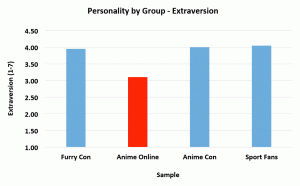
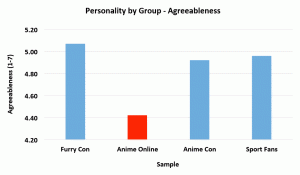
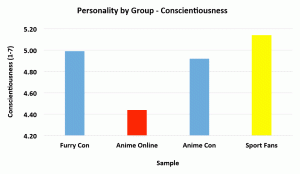
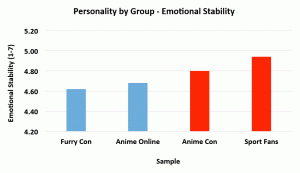
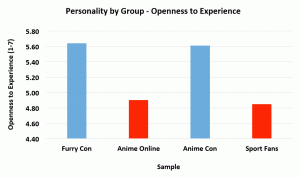
I am confused about the agreeableness stat listed here. Do you mean agreeable as in; more willing to take risks/take part in a new sensation or experience (Say for example, trying out a new ice cream flavor), or do you mean agreeableness as in; receptiveness to new ideas or change? I know these might sound similar, I apologize for any confusion, but my basic question is one of semantics: I have heard the term “agreeable” used to describe if someone is in a foul mood or not, i.e., “He’s being very disagreeable right now, don’t talk to him”. But I’ve also heard it used to describe someone’s openness to new things, i.e., “He’s quite agreeable when it comes to change.”
In short, are you saying furries are grumpy, or just close-minded?
(I apologize again for the long winded response.)
It’s “agreeableness” as defined by the TEN ITEM PERSONALITY MEASURE (TIPI) Also found in footnote (above) but below the main charts 🙂